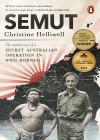Written by: Christine Helliwell
Penguin Random House, 2021, 512 pp
Paperback ISBN: 9780143790020
Reviewed by: Peter J Dean
We read books with predetermined ideas and biases. I approached Christine Helliwell’s book Semut: The Untold Story of a Secret Australian Operation in WWII Borneo firmly cloaked in the regalia of my academic background as a specialist in Australian strategy and military operations. As well as studying the Borneo campaigns closely, I have walked the battlefields at Tarakan, Brunei Bay and Balikpapan, and I have trekked into the interior of Borneo where part of the SEMUT operations were undertaken in collaboration with the local Dayak people. So I approached this work with a combination of professional interest and trepidation.
My professional interest was driven by the nature of the SEMUT operations, their relationship to the broader Australian operations in Borneo during 1945, and the rudimentary nature of Australia’s Special Forces operations at the time. For those of us working in this field, it is an interesting and potentially important operation that has traditionally been seen as peripheral to the larger conventional operations undertaken by the 9th Australian Division in the area. Despite the allure of the ‘special’ nature of these operations—Special Forces being an area of military history that, for good or ill, is now deeply ingrained in the nation’s understanding of our more recent military history—they have been devoid of any close or authoritative study.
My excitement was driven not only by the release of another book on the Pacific War but also by the fact that this work had chosen a fascinating section of the Australian operations in Borneo during 1945. For too long, Australia’s military operations in the Pacific War, apart from the Kokoda Trail, have lived in what Peter Stanley once described as a ‘Green Hole’—as mysterious and unknown as the jungle that surrounded them.
The year 1945 is a particularly interesting and important one in Australia’s military history. Yet the events of that year are neither well known nor well understood. They also remain controversial. For instance, the well-known British military historian Max Hastings has claimed that Australia’s military efforts in 1945 represented a case of ‘bludging’. Hastings’s hyperbolic assertions have been systemically rebuffed, but the operations in New Guinea and the South Pacific have often been derided as nothing more than ‘mopping up’, and the Borneo operations putatively undertaken for uncertain strategic reasons.
A number of key features are immediately apparent. Semut is written for a popular audience—one of a plethora of books in this genre that many academics of Australian history at various universities lament (often rightly) as poor history, with little analysis and adding nothing new. Indeed, the cover endorsement comes from one of the doyens of this genre: Paul Ham. It is written by a non-military historian. My confidencein Helliwell’s academic credentials was tempered by her training as an anthropologist, her (self-described) ignorance of military history at the start of the project, her deep and seemingly overly emotional connection to the subject matter, and the use of ‘untold’ in the subtitle of the book.
Yet Helliwell’s passion for, and deep understanding of, Borneo and its indigenous people, based on her decades of anthropological work, shine through. She has backed up this experience with an almost equal dedication to pursuing the most remote historical sources; this gives the work an outstanding foundation. Helliwell brings to life the remarkable story of the efforts of a handful of Australian, British and New Zealand soldiers of the Services Reconnaissance Department (SRD) to recruit and train the local Dayak people to fight a guerrilla campaign against the occupying Japanese forces in the prelude to the Australian invasion of the area in June 1945.
Through the author’s anthropological training, the Dayak people inject themselves into the text, which is not the case in conventional military histories. Semut chronicles the courageous exploits of the SRD but also weaves in the true partnership with the Dayak people. Helliwell brings to life their customs, culture and local politics, as well as their relationship to the British Empire, the Japanese occupation and the SRD mission.
Despite the author’s obvious personal connection to Borneo and its Dayak people, she strives to achieve a level of objectivity as she describes their critical role in this fascinating history. The book details in equal measure the heroism of the SRD soldiers and the embryonic nature of Australian special operations at the time: outlining the difficulties, the limited planning and logistics, the lack of reinforcements, and the scarcity of equipment. Written in a lively style, Semut maps out some clear villains among the Japanese, elements of the Australian high command, and some of the personalities of the SRD commanders, and offsets these with the courage of the SRD operatives and the local guerrillas.
While on balance this is a fine book, it does have limitations. It is overlong in its focus on minutiae. It is 70 pages before we get an introduction to the SRD and the operations background. It devotes too much time to covering almost every detail of background and planning, as well as recounting almost every encounter of the SRD with every long house in Borneo—no small feat given the limitations of the source material.
Helliwell is brilliant at evoking the lives of the Dayak people and their leaders, the SRD operations and their tensions, risks, successes and failures, but she could have done so in a more focused manner. While the focus improves as the work progresses, and while Helliwell achieves a fine rhythm in Part III, it does recount elements of the narrative that could easily have been covered more succinctly.
More frustratingly, the book eschews a detailed analysis of the strategic and operational outcomes of the two SEMUT operations that it covers—something we must await in the second volume. As it struggles to link the tactical action of the SRD in Borneo to the focus of Australian and Allied strategy, at times the book also reveals a lack of understanding of the limitations that such operations have on broader national strategy. I was left wondering whether, for all the amazing feats of the Dayak people and the SRD, it would have been better had this operation not been undertaken.
Overall, Semut is a fine piece of work. Passionate yet largely balanced, it brings to life the people, places and events of operations SEMUT II and III. It is a highly readable and compelling narrative. It strives to be an accessible and engaging history for public consumption. Christine Helliwell has produced a detailed and authoritative study.
About the Reviewer
Professor Peter J. Dean PhD SFHEA has an extensive background in military and defence studies. He is the Director, Foreign Policy and Defence at the United States Studies Centre at the University of Sydney. Previously he was the University of Western Australia’s (UWA) first Chair of Defence Studies and the inaugural director of the UWA Defence and Security Institute. Professor Dean has authored numerous books and articles on the US-Australian alliance, Australian defence policy and military operations.


